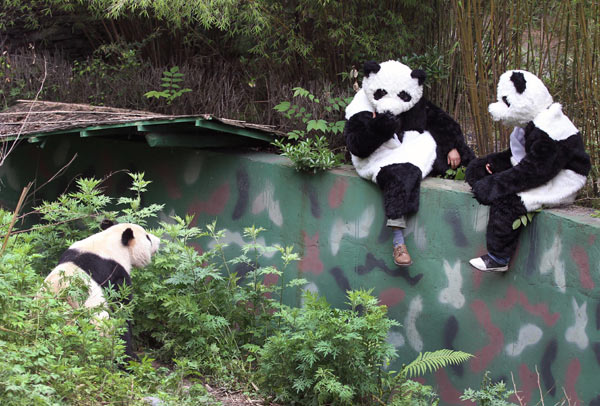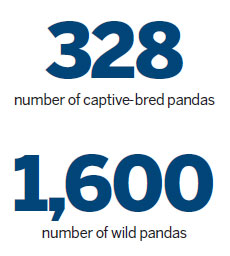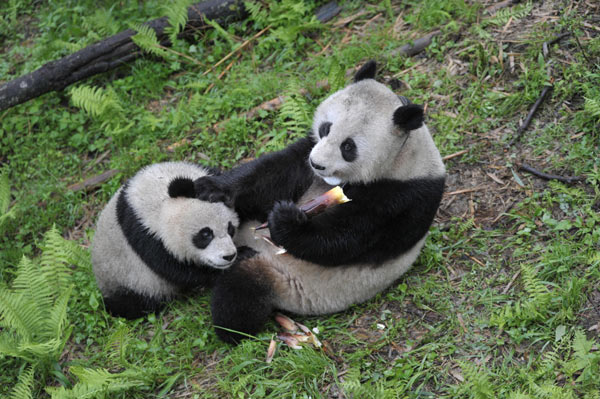Pandas set to take a walk on the wild side
Updated: 2012-06-08 08:07
By Jiang Xueqing and Huang Zhiling (China Daily)
|
||||||||
Bears to be released into natural habitat, Jiang Xueqing and Huang Zhiling report from Wolong and Dujiangyan, Sichuan province.
It took at least two hours for our all-terrain vehicle to bump along the rugged mountain road from Dujiangyan, a city near Chengdu in Sichuan province, to the Wolong National Nature Reserve. Devastated by the 2008 Wenchuan earthquake and subsequent mudslides, the dangerous state of the road means that very few tourists ever visit Wolong.
 |
|
Researchers dressed in panda costumes during a training session at the China Conservation and Research Center for the Giant Panda in Wolong, Sichuan province. Feng Yongbin / China Daily |
Tao Tao, a male panda cub aged almost 2 years, lives with his mother, Cao Cao in this isolated place that boasts scenery reminiscent of the elf kingdom in Lord of the Rings, and has seen few human visitors in the last four years.
Born in captivity on Aug 3, 2010, Tao Tao has been undergoing training in field survival techniques with the help of researchers from the China Conservation and Research Center for the Giant Panda almost since the day of his birth. The plan is to send him into the wilds of Ya'an, Sichuan province, by the end of October.
Pandas are an endangered species. According to Huang Yan, deputy chief engineer of the center, captive-bred pandas number just 328 and there are only around 1,600 in the wild. The wild pandas are scattered across the provinces of Sichuan, Gansu and Shaanxi. During the past 10 years, human activity, mainly in the form of roads and high-speed rail tracks, has cut into their habitat and divided the wild pandas into more than 30 small groups.
|
 |
"We have no choice but to release captive-bred pandas into the wild to protect the natural environment," said Huang. "By providing wilderness-survival training for these animals, we hope to introduce them into a number of small groups, helping to increase the wild population and maintain their genetic diversity."
A short while after Tao Tao was born, the researchers placed the cub and his mother in a semi-wild area covering 2,400 sq m at a height of 1,820 meters above sea level. Unusually, Cao Cao was allowed full responsibility for the cub, a break from the usual practice employed at centers such as Bifengxia Panda Base in Ya'an, where keepers care for cubs and feed them formula milk.
During the training process, the mother plays the lead role in teaching the cub basic survival skills, such as how to find water and climb trees. The researchers play a secondary role by placing the pandas in an environment similar to their natural wooded habitat, providing the mother with food when bamboo is scarce, and monitoring their behavior and activities. In addition to Tao Tao, three other panda cubs are receiving the same kind of training from their own mother.
"We used to teach panda cubs based on our research and imagination. It took a lot of time and energy, but results were minimal," said Zhang Hemin, director of the center. "Now, we rely on panda mothers to do the training. They are much better teachers than humans, because they have an innate knowledge of what to do in the field."
Unlike some other nature reserves where the cubs develop close relationships with their keepers, in Wolong the researchers are kept virtually invisible to the cubs to minimize the impact of humans on them. The keepers and veterinarians even wear fluffy black-and-white costumes when the cubs are given a physical examination. As a result, Tao Tao has learned to be constantly vigilant and if he hears the sound of footsteps on bamboo leaves, he immediately hides by climbing the nearest tree.
 |
|
Tao Tao (left), tries to get close to his mother Cao Cao in their semi-wild environment. Provided to China Daily |
On Feb 20 last year the researchers moved Tao Tao and his mother to a larger area, higher up the mountain. The area covers 40,000 sq m and is at an altitude of 2,000 to 2,100 meters above sea level. More than 10 wild pandas live on the outskirts of the training zone, which has plenty of umbrella bamboo, one of the most common varieties of the plant in Wolong. The environment is almost exactly the same as the pandas' natural habitat in the woods.
To prevent Tao Tao and Cao Cao from leaving the training area, they are enclosed by a 2.5-meter-tall fence. The scientists installed 55 cameras, both along the fence and inside the training area, to monitor the pandas. They also use binoculars to conduct long-range observation. Pandas are solitary and sedentary by nature and most of the time Tao Tao rests in the trees, only returning to his mother when he is hungry.
The cameras do not always work effectively and can barely detect the pandas when thick leaves cast their shadows across the fields, so researchers fitted Cao Cao with a GPS collar, enabling them to pinpoint her position and sphere of activity. The collar receives satellite signals that record the panda's longitude and altitude at any given moment and allows the researchers to download data from a distance of approximately 500 meters, although sometimes the thick foliage means that they have to approach as close as 100 meters.
The scientists now plan to make a model leopard, cover its body with excrement and urine collected from the zoo and record leopard roars. Eventually, the model will be placed inside the living area and a researcher will hide in a camouflaged watchtower. When Tao Tao passes close to the model, the researcher will activate a remote control to make the fake leopard roar and then observe Tao Tao's reaction. Using this technique, they hope to scare the cub and teach him how to identify and avoid natural enemies.
"As researchers, we are most worried about whether he can make it in the wild," said Zhang, the director of the center. Those concerns were especially acute at the beginning of the training period. Around 10 days after Tao Tao was born, Wolong was battered by a heavy two-day rainstorm. Everyone at the center was wracked with anxiety and a heated debate ensued as the researchers argued over whether to take the cub back to the center.
In the end, Zhang decided to take a risk. "We have to clench our teeth to surmount this barrier," he said. "If we take him back now, we'll have to take him back next time a similar problem crops up. So we have to take a brave step. Even if he dies, he'll be making a sacrifice for the salvation of his own species." To the relief of all the researchers, Tao Tao came through the rainstorm unscathed.
Concerns were again aroused during a heavy snowstorm in February 2011. Some parts of the training area, including the bamboo plantations, were buried in snow a meter deep. At the time, Tao Tao had just learned to walk and the researchers were afraid he would perish in the severe cold. However, their concerns were proved unfounded when they discovered that Cao Cao had trodden a path in the snow so that Tao Tao could follow in her footsteps. Later, the mother protected her offspring by driving a mask palm civet out of their living area.
"Now we have learned the lessons and realize that panda cubs must be steeled through bad weather and tough environment. It's the only way they will learn to adapt to this habitat," said Zhang.
After nearly two years of training, Tao Tao exhibits few differences to wild pandas in terms of food-base selection, searching out sources of water, orientation, evasion of enemies, and social communication, according to Zhang.
On May 3, Tao Tao and his mother were moved to a 240,000-sq-m area higher up in the mountain. By the time the pandas left, the cub already weighed 36 kg. Now, until October, the training schedule will focus on identifying natural enemies and friendly animals. The researchers also plan to buy some wild boar and goats and introduce them into the training area. They will also transfer a small number of pandas to Wolong from Ya'an so that Tao Tao can develop social connections and understand his place within the panda community.
"Our next step will be to form a standardized procedure for wilderness-survival training and establish a training plan with an annual target number," said Zhang. "That way we'll have a steady flow of pandas that fit the criteria to be released into small wild groups, integrate with the local community and breed. After years of hard work, we will finally achieve our goal of protecting the wild pandas, increasing their population and preserving their genetic diversity."
Contact the reporter at jiangxueqing@chinadaily.com.cn

 Relief reaches isolated village
Relief reaches isolated village
 Rainfall poses new threats to quake-hit region
Rainfall poses new threats to quake-hit region
 Funerals begin for Boston bombing victims
Funerals begin for Boston bombing victims
 Quake takeaway from China's Air Force
Quake takeaway from China's Air Force
 Obama celebrates young inventors at science fair
Obama celebrates young inventors at science fair
 Earth Day marked around the world
Earth Day marked around the world
 Volunteer team helping students find sense of normalcy
Volunteer team helping students find sense of normalcy
 Ethnic groups quick to join rescue efforts
Ethnic groups quick to join rescue efforts
Most Viewed
Editor's Picks

|

|

|

|

|

|
Today's Top News
Health new priority for quake zone
Xi meets US top military officer
Japan's boats driven out of Diaoyu
China mulls online shopping legislation
Bird flu death toll rises to 22
Putin appoints new ambassador to China
Japanese ships blocked from Diaoyu Islands
Inspired by Guan, more Chinese pick up golf
US Weekly

|

|






